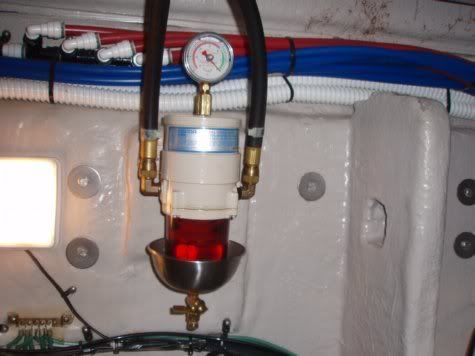Survey was done on a 1999 400DA with 3116 350HP engines, 450 hrs and a couple things came up I wouldn't mind some feedback on. Sorry for the long post..
1. Small Racor fuel filters commented on by the Cat technician. I have seen posts about this before. Low fuel pressure was found in both engines, and by low I think his measurements were like 10 and 16. He commented VERY low pressure and said this is the most likely culprit if they were blocked filters. Then neither engine was able to get to 2800 WOT, they were 2740 and 2765. The plan is to get the filters changed and retest fuel pressure and WOT rpm. Anything else I should be concerned with?
2. Cat tech commented that all of the hoses and belts were original ( 10 yrs ) and he suggested they be changed on both engines ( big $$$$ apparently ). No obvious signs of wear on any of the hoses. What is the realistic time period/hrs these things get changed?
3. Assuming the heat exchangers have never been cleaned, what should i expect with them? Temps were within spec ( approx 180 ) but tech commented he would like to have seen a better temp difference between intake and outgoing with the current water temp/air temp. Where do you go to get them cleaned, assuming I can get it off myself. I don't think they have ever been cleaned.
4. I wish I would have ridden on a diesel boat before this. Since it was my first time, i didn't know what was normal sounds vs. a potential problem. Anyone familiar with a whinning noise at the helm that seems to get worse at higher rpm?
1. Small Racor fuel filters commented on by the Cat technician. I have seen posts about this before. Low fuel pressure was found in both engines, and by low I think his measurements were like 10 and 16. He commented VERY low pressure and said this is the most likely culprit if they were blocked filters. Then neither engine was able to get to 2800 WOT, they were 2740 and 2765. The plan is to get the filters changed and retest fuel pressure and WOT rpm. Anything else I should be concerned with?
2. Cat tech commented that all of the hoses and belts were original ( 10 yrs ) and he suggested they be changed on both engines ( big $$$$ apparently ). No obvious signs of wear on any of the hoses. What is the realistic time period/hrs these things get changed?
3. Assuming the heat exchangers have never been cleaned, what should i expect with them? Temps were within spec ( approx 180 ) but tech commented he would like to have seen a better temp difference between intake and outgoing with the current water temp/air temp. Where do you go to get them cleaned, assuming I can get it off myself. I don't think they have ever been cleaned.
4. I wish I would have ridden on a diesel boat before this. Since it was my first time, i didn't know what was normal sounds vs. a potential problem. Anyone familiar with a whinning noise at the helm that seems to get worse at higher rpm?






